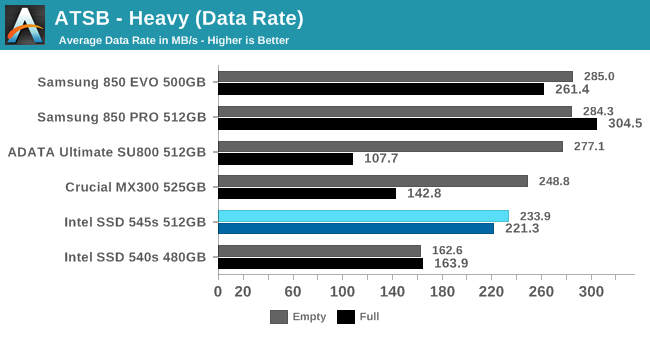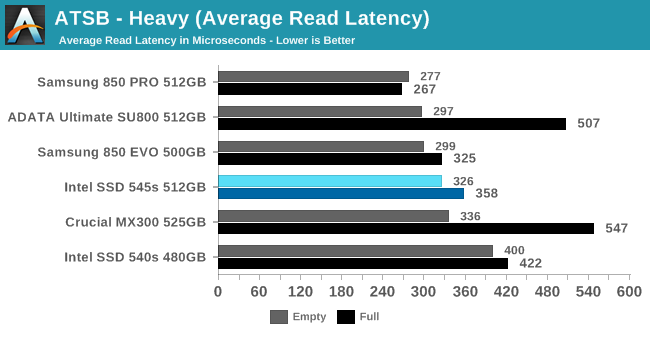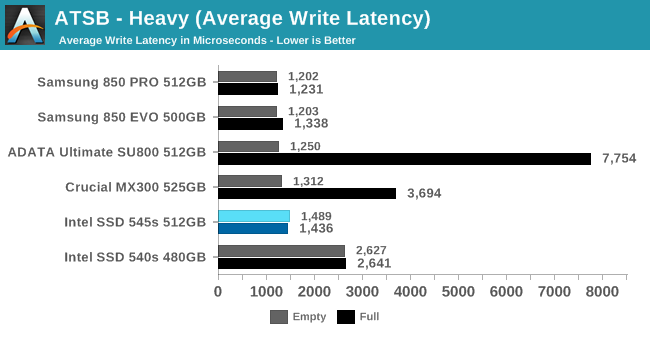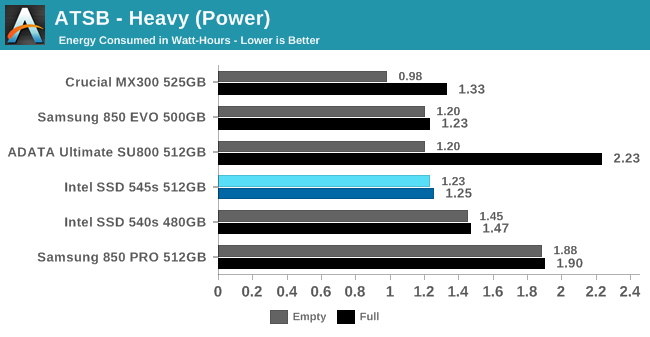The Intel SSD 545s (512GB) Review: 64-Layer 3D TLC NAND Hits Retail
by Billy Tallis on June 27, 2017 6:00 AM ESTAnandTech Storage Bench - Heavy
Our Heavy storage benchmark is proportionally more write-heavy than The Destroyer, but much shorter overall. The total writes in the Heavy test aren't enough to fill the drive, so performance never drops down to steady state. This test is far more representative of a power user's day to day usage, and is heavily influenced by the drive's peak performance. The Heavy workload test details can be found here. This test is run twice, once on a freshly erased drive and once after filling the drive with sequential writes.

The Intel SSD 545s shows substantial improvement over the 540s in average data rates for the Heavy test. The 545s is not quite able to compete against Samsung as was the case for The Destroyer, but it comes much closer than its predecessor.
The 545s also fares far better when the test is run on a full drive than the drives that use the previous generation 32L 3D TLC (ADATA's SU800 and Crucial's MX300). Both of those drives beat the 545s when the test is run on an empty drive, but suffer a huge performance loss when the drive is full.

The latency measurements for the Intel 545s on the Heavy test tell a similar story to the average data rates. Intel is now in the same league as the other 3D NAND SSD, though still in last place. When the test is run on a full drive, the Crucial and ADATA drives fall apart and average latency spikes to the 2–4ms range while the latency of the Intel 545s is unaffected and remains well below 1ms.


The read latency of the older Intel 540s is not too far behind the 3D NAND drives and it handles being full with no trouble, but its write latency in either case is almost twice as high as the 3D NAND drives. The biggest improvement of the Intel 545s comes from cutting that write latency. The read latency also improved enough to surpass the Crucial MX300.

The energy usage of the Intel 545s during the Heavy test has it essentially tied for second place with the Samsung 850 EVO, while the Crucial MX300 has the clear lead when the test is run on an empty drive. The MX300's advantage disappears when the test is run on a full drive and the SU800's energy usage almost doubles.










74 Comments
View All Comments
shutkajri18 - Thursday, June 29, 2017 - link
That is a cool SSD but do you wanna check out these hot model then go to /hotwalpapers.com\Oxford Guy - Saturday, July 1, 2017 - link
"Intel's 600p NVMe SSD is currently only $175 on Newegg. Since the 600p outperforms any SATA SSD for typical real-world desktop use, the 545s needs to do better than 35¢/GB."Put the 600p into the performance comparison screens.
hanselltc - Monday, July 3, 2017 - link
So between this and Samsung 850 EVO I simply pick the cheaper one at the time of purchase? All SSD in my house are 850 EVO and I kinda got bored.Adam-James - Tuesday, July 25, 2017 - link
It's 2017. Please stop making AHCI SATA drives. At this point we should have long ago transitioned to SATA Express for entry level drives, M.2 for laptop storage, U.2 for high end desktop storage, and NVMe for all of it. Instead the industry's become so complacent that it's looking like we're gonna be stuck in SATA III hell for eternity.